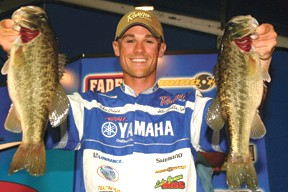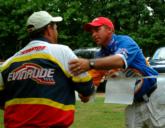FLW Tour preview: 2003 FLW Championship, James River, Sept. 10-13
Tidal waters, good holding areas keys to fishing success on James River

RICHMOND, Va. – In many respects, the site of the 2003 FLW Championship couldn’t be a more appropriate setting. While most of the regular-season tournaments this past season have taken place on reservoirs and natural lakes, bodies of water that are fairly predictable in their bass holdings, the James River represents possibly the most difficult waterway the anglers will fish all year. Not only are there more than 300 miles of river to choose from, but anglers will also have to contend with the fact that the James River is a tidal fishery. As a result, even when the anglers do find the fish, there is no guarantee that a productive “honey hole” won’t simply disappear with the tides.
“There are two keys to fishing the James River,” said 2003 FLW Tour Angler of the Year Dan Morehead. “First and foremost is learning the tides. As far as I’m concerned, there is going to be a three-hour window of opportunity to catch fish – the last hour of outgoing tide, low tide and the first hour of incoming tide. The second most important thing is going to be location. Some areas are going to be holding fish better than others, and, obviously, whoever finds those  spots is going to be in better shape. But if you don’t understand how the tides are going to affect the fish in your area, you’re going to be in trouble.”
spots is going to be in better shape. But if you don’t understand how the tides are going to affect the fish in your area, you’re going to be in trouble.”
Clark Wendlandt, the FLW Tour’s angler of the year in 1997 and 2000, agrees that anglers will have to pay close attention to the tides if they are to have any hope of winning the title and the lucrative $500,000 first-place prize.
“The main thing is figuring out how the fish are going to change up in your area when the tides move,” said Wendlandt. “It’s also a huge body of water with very little vegetation. So anglers are going to have to focus on rocks, wood and current breaks – any areas where the bass are going to have an opportunity to ambush their prey. The James River has also received a lot of rain in the past few months, so there is going to be plenty of water to fish. My guess is that you’ll be able to find fish all over the river. In my opinion, the James River is going to fish bigger than usual.”
River history and facts
Spanning nearly the entire state of Virginia and stretching almost 340 miles from east to west, the James River represents the longest continual waterway in the nation completely contained in one state. Originally known as Powhatan’s River by the Native Americans inhabiting that area of the state, the river was eventually renamed the James River after Captain John Smith – one of the earliest explorers of the waterway – decided to personally honor the King of England, James I. Jamestown, the first permanent English settlement in colonial America, was also founded on the banks of the James River in 1607. Located in the Triassic Basin area, the historic James River also has been known to harbor artifacts on its shoreline dating back more than 11,000 years.
A tidal waterway, the James River is formed by the confluence of the Cowpasture and Jackson rivers in the foothills of the Allegheny Mountains in the western portion of the state. Eventually, the river empties into the Chesapeake Bay in the east, which in turn flows into the Atlantic Ocean. As a result, the James River has a higher salt concentration as the river meanders toward the Chesapeake Bay.
Throughout the western portion of the James River, anglers should be able to find large concentrations of smallmouth bass as well as smaller pockets of spotted and largemouth bass. Bass fishing is generally good throughout the upper river as there is reportedly little difference in fish populations from one area to another. However, from Scottsville toward the falls near the City of Richmond, bass tend to be fewer in population but also larger, on average, in size.
In the lower (or eastern) part of the river, anglers will have to contend with the tides as well as some brackish water as they make their way toward the Chesapeake Bay. However, largemouth bass fishing is excellent here, with plenty of action in old river channels and abandoned gravel pits (upstream from the city of Hopewell) and in larger tributary creeks (downstream from Hopewell). Creeks between Hopewell and Hog Island also reportedly provide a thriving largemouth bass population as a result of the abundant amount of shoreline structure such as fallen trees and pier pilings as well as large areas of vegetated tidal flats and channel drop-offs.
Technique, experience and avoiding barnacles other keys to success
Because a large number of FLW Tour anglers haven’t had much experience fishing the James River, a difficult river to fish in any setting, the tournament should be a true test of an angler’s fishing acumen.
“Since it is such a dynamic fishery, I think people who know tidal fishing and-or have experience on the river in the past will have an advantage,” said Wendlandt. “That’s not to say some of the younger guys won’t find a big pocket of fish. But in general, having some experience is going to help. There will definitely be a lot of interesting things going on. You not only have to contend with the tides, but you also have to figure out how far (east) you can go before the water gets too salty to sustain bass. Barnacles could also be a factor. A lot of anglers are going to lose fish because their lines are going to break off on the barnacles. You’re going to hear a lot of heartbreaking stories before this tournament is over, that’s for sure.”
Morehead believes that while some anglers will have a slight advantage, for the most part, the tournament should be largely up for grabs.
“Some of the anglers with more experience might be able to play the tides a little bit better because a lot of the younger guys really haven’t been thrown in this situation before,” said Morehead. “But I think that, for the most part, it’s going to be a fairly level playing field. There are just so many things to contend with that you’re really going to have to play a lot of things by ear.”
Both Morehead and Wendlandt, two of the early favorites to capture the title, believe that shallow-water techniques will most likely dominate the tournament.
“In my opinion, it’s definitely going to be a shallow-water tournament,” said Morehead. “You’re going to see a lot of flipping and pitching, spinner baits, and maybe some shallow crankbaits around the wood and rocks.”
“The main ways people are going to fish are going to be flipping and throwing small crankbaits or spinner baits,” said Wendlandt. “But I also don’t think you’re going to see any huge stringers either. I think that 10 pounds will be a respectable weight and 12 pounds is going to be a very, very good weight.”
Bracket-style format another curveball for anglers
The 2003 FLW Championship employs a unique format that pits angler against angler in a series of head-to-head matchups for the majority of competition. Heading into the tournament, all championship anglers received seeds ranging from one to 48 based on year-end FLW standings points. Once the tournament begins, the No. 1 ranked angler (FLW Tour veteran Dan Morehead of Paducah, Ky., holds the distinction this year) will be matched with the 48th-ranked angler (Alvin Shaw of State Road, N.C.). Second-ranked angler David Dudley of Manteo, N.C., takes on 47th-seeded angler Jim Moynagh of Carver, Minn., and so on down the line.
For the first two days of competition, pro anglers will compete in bracket-style head-to-head matchups against one opponent. Whoever brings the most weight to the scales in each of those head-to-head matchups over the course of two days will advance to the “Round of 24” on Friday. Consequently, 24 anglers in each division will be eliminated after the second day of competition.
On Friday, the winners in each of the first-round brackets will again be paired off for another day of head-to-head competition. Whoever brings in the most weight during each of those 12 one-day matchups will advance to the finals. The result is that another 12 anglers will be eliminated on Friday, while the remaining 12 winners will advance to Saturday’s finals.
On the final day of competition, the advancing 12 pros will have all of their weights zeroed. Then the finalists will head out onto the open waters of the James River in a one-day battle for the first-place prize of $500,000.
Co-angler championship follows standard format
In the Co-angler Division, the full field – determined by the top 48 anglers in the year-end standings – will fish the first two days of competition. After Thursday’s weigh-in, the top 24 co-anglers who bring in the largest combined two-day stringers will make the cut and earn a berth in Friday’s co-angler finals. There is no head-to-head competition for co-anglers. On Friday, the top 24 anglers who survive the first two days of competition will have their weights reset to zero. After one more day of fishing, the co-angler champion will be crowned.
Big guns have confidence
Arguably the hottest angler on the tour this year, Morehead has had the 2003 FLW Championship circled on his calendar for over a year now. And, not surprisingly, he believes that he has a good shot at adding the prestigious championship trophy to his long list of amazing accomplishments this season.
“I’m not approaching this tournament thinking that I’ve already had a good year and whatever happens, happens,” said Morehead, the overall top seed heading into the championship. “I’m going in with the mindset that I’m going to win this tournament. That’s been my main goal all year. With $500,000 on the line, anything less than first place is going to be a disappointment.”
Wendlandt, the third overall seed, doesn’t see things much differently.
“I’ve prepared harder for this tournament than any other tournament of my career,” he said. “Although it’s going to be a tough tournament and a lot of pressure, I really like my chances. But then again, with this type of format, you can never really count anyone out. It’s going to be exciting, that’s for sure.”
Link: